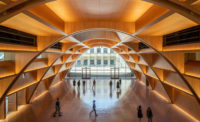Equal Justice Initiative Legacy Pavilion
Montgomery, Ala.
Best Project
Owner: Equal Justice Initiative
Lead Design Firm: Williams Blackstock Architects
Contractor: Bailey-Harris Construction Co.
Structural Engineer: Structural Design Group
MEP Engineer: Bernhard TME
Civil Engineer: LBYD Engineers
A drab tilt-up concrete warehouse and featureless parking field have been transformed into a space dedicated to understanding the nation’s legacy of slavery, lynching and segregation. Serving as a welcome center for the Legacy Museum and the National Memorial for Peace and Justice, the new pavilion contains a ticket office, gift shop, coffee shop, a restaurant, exhibit space and a shuttle transit hub.
Because the site’s many decades of diverse uses presented a host of undocumented subsurface conditions, civil engineering firm LBYD Engineers and the rest of the project team collaborated to formulate the most economically efficient and resourceful solutions, including fast-tracking the civil engineering design to expedite permit applications. Regular teamwide communication addressed design refinements, owner- and regulatory-driven scope changes and other issues in order to preserve the project’s original vision while also maintaining the aggressive 10-month construction schedule.
Unannounced weekly visits by the project team’s safety director encouraged compliance with all appropriate safety measures. Any safety infractions were documented via reports and photographs to help guide remedial action and foster further training and discussion. These and other efforts resulted in zero recordable incidents or lost-time injuries over nearly 44,000 work hours.
Stretching across the pavilion’s west facade is its signature design element—images of seven key civil rights figures from Montgomery depicted on 126 perforated stainless steel panels. Varying in size, the perforated holes are aligned on an orthogonal grid. When arranged and aligned appropriately, including perforations which span the seam between two adjacent panels, the contrast between the darkness of the holes and brightness of the remaining stainless steel throughout the day allows the images to emerge from the screen surface.
By placing the facade so that the iconic civil rights figures look out into the city where history was made, visitors gain a greater understanding of Montgomery’s unique role in fueling a civil rights movement that continues to reverberate around the world.
Sitting atop a raised plinth, the pavilion and its full-length porch front a new park that contains a reflection garden featuring a monument to women, men and children who were victims of racial terror lynchings. A black granite monolith fountain memorializes more than 2,000 people who were lynched between 1865 and 1876. Connecting these memorials is a concrete paver walking path interspersed with areas that allow for infiltration of stormwater to an underground collection system for discharge off site.
Return to Southeast Best Projects Award Winners Stand Tall in 2020







